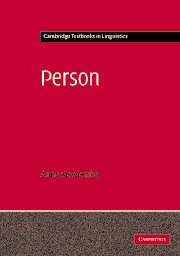Book contents
- Frontmatter
- Contents
- List of figures
- List of tables
- Preface
- List of abbreviations
- 1 Introduction
- 2 The typology of person forms
- 3 The structure of person paradigms
- 4 Person agreement
- 5 The function of person forms
- 6 Person forms and social deixis
- 7 Person forms in a diachronic perspective
- Appendix 1 List of languages in the sample by macro-area
- Appendix 2 Genetic classification of languages cited in the text
- References
- Author index
- Language index
- Subject index
1 - Introduction
Published online by Cambridge University Press: 05 June 2012
- Frontmatter
- Contents
- List of figures
- List of tables
- Preface
- List of abbreviations
- 1 Introduction
- 2 The typology of person forms
- 3 The structure of person paradigms
- 4 Person agreement
- 5 The function of person forms
- 6 Person forms and social deixis
- 7 Person forms in a diachronic perspective
- Appendix 1 List of languages in the sample by macro-area
- Appendix 2 Genetic classification of languages cited in the text
- References
- Author index
- Language index
- Subject index
Summary
The notion of person has been widely discussed in many different fields of study including philosophy, sociology, anthropology, psychology, politics, religion, literature and art. Scholars who have addressed the issue of person within these fields have been concerned with questions such as what is a person, who qualifies as a person, what are the cross-cultural differences in the conceptualization of person, what is the relationship between individual identity and person, how do we identify and reidentify someone other than ourselves, when does a person stop being a person, etc. Though the social and cultural construal of personhood is also a topic of concern within linguistics, particularly sociolinguistics and anthropological linguistics, the notion of person in linguistics is primarily conceived of as a grammatical category, on a par with gender, number, case, tense, etc. Accordingly, it is with person as a category of the grammatical system of languages that this book will be primarily concerned.
Person as a grammatical category
It is often stated that the grammatical category of person covers the expression of the distinction between the speaker of an utterance, the addressee of that utterance and the party talked about that is neither the speaker nor the addressee. The speaker is said to be the first person, the addressee the second person and the party talked about the third person. This, however, is not quite correct. What is missing from the above characterization is the notion of participant or discourse role.
- Type
- Chapter
- Information
- Person , pp. 1 - 15Publisher: Cambridge University PressPrint publication year: 2004

